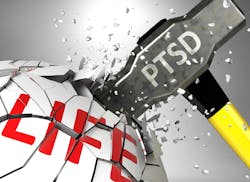The term “post-traumatic stress disorder (PTSD)” is not one traditionally associated with the workplace. Unfortunately, some employees are experiencing “shocking, scary and even dangerous events,” which is how The National Institute of Mental Health defines PTSD.
The incidence of dangerous events at work is high. According to the Department of Justice, annually 2 million people are victims of non-fatal violence in the workplace. And even more unsettling is the fact that 1,000 workplace homicides occur each year.
In fact, an average of 13 fatal work injuries occur every day. And let’s not forget the amount of trauma that resulted from, and is still attributed to, the pandemic. The Mental Health Index says that the risk of PTSD among employees is up 121% from 2020. Considering all of these statistics provides a scope of how huge this problem is.
The accompanying health effects on workers in dealing with this issue can include increased substance abuse, fatigue and mood swings, as well as many other symptoms. And from an organizational perspective, the effect of trauma can present as frequent accidents, poor performance and interpersonal conflicts.
In response to this, what can a company do? The State of Rhode Island offers this advice to employers:
1. Education and Awareness: Employers and employees alike need to understand the prevalence and impact of trauma. Training programs can help raise awareness about trauma's signs and symptoms, fostering empathy and reducing stigma.
2. Safety and Support: Trauma-informed workplaces prioritize physical and psychological safety for all employees. This includes implementing policies to prevent retraumatization, such as clear communication channels for reporting harassment or discrimination, and providing access to confidential support services.
3. Empowerment and Choice: Recognizing that trauma can strip individuals of their sense of control, trauma-informed workplaces empower employees by offering choices and autonomy whenever possible. Flexible work arrangements, opportunities for skill development, and participatory decision-making processes can all contribute to a sense of empowerment.
4. Cultivating Resilience: Building resilience is essential for coping with trauma and adversity. Trauma-informed workplaces invest in programs and resources that support employees’ mental and emotional well-being, such as counseling services, mindfulness training and peer support groups.
5. Collaboration and Community: Ttrauma-informed workplaces foster a culture of collaboration and community, where employees feel connected, valued and supported by their peers and supervisors. Strong social support networks can buffer the impact of trauma and promote recovery.
Another resource is a recently released survey, “Introduction to Trauma-Informed Workplaces for HR,” from McLean and Company. “Becoming trauma-informed is a proactive approach to promoting health and preventing harm that demonstrates organizational support of well-being and safety for all individuals," says Elysca Fernades, director of HR research and advisory services at McLean & Company, in a statement. “Failing to intentionally be a trauma-informed organization risks the psychological safety and well-being of individuals in the organization who have survived trauma, are experiencing trauma, or may encounter trauma in the future.”
For the foreseeable future, the main causes of trauma on the job—workplace violence and fatal injuries—have not shown to be substantially diminishing, so employers need to ensure that they are dealing with this issue and providing employees with the means to address trauma. A particularly poignant comment came from Tonya Ford, a family liaison for OSHA, in a blog on the Department of Labor website: “Today, take a moment to consider those forced to survive in the aftermath of a work-related fatality. If you know someone who’s faced the unimaginable loss of a loved one in a job-related tragedy, share your concern or just let them know you care.”
About the Author
Adrienne Selko
Senior Editor
Email [email protected]
Adrienne Selko is also the senior editor at Material Handling and Logistics and is a former editor of IndustryWeek.

